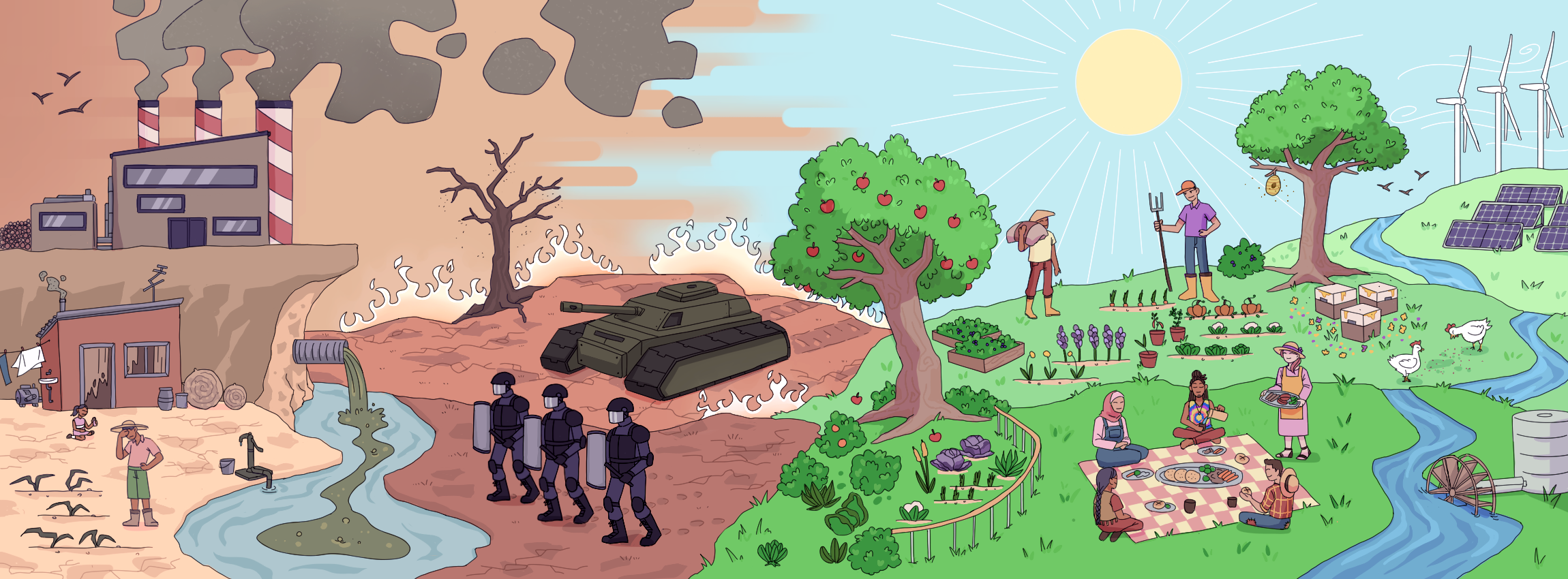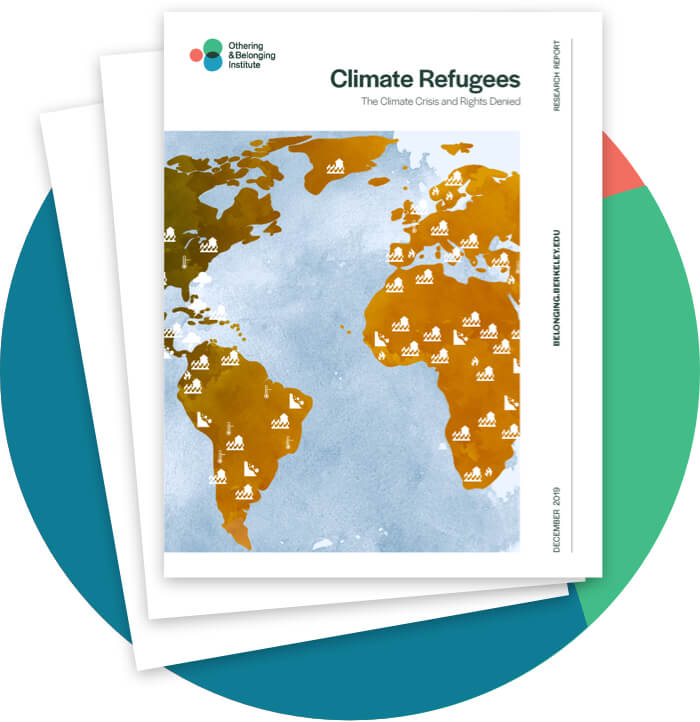Bahrain
Introduction to Bahrain
Bahrain is a small, desert-covered island state in the Persian Gulf that has a population of 1.49 million1 , of which 10% is rural.2 The King Fahd Causeway, a 15-mile-long series of bridgeways, connects the country to Saudi Arabia. As a hyper-arid country, the island faces a uniform hot desert climate with almost no nutrient-rich land except for the northern “fertile strip” with minimal agriculture.3 Bahrain is highly vulnerable to the impacts of the climate crisis, which include high risk for extreme heat, increased droughts, lack of rainfall and water resources, and coastal floodings.4 The country’s population distribution is also highly unequal, with the majority of the infrastructure and population residing in the northern part—especially in the capital city of Manama—while there is little development and permanent settlement in the southern part of the island.5 In addition to its immense oil and gas reserves, Bahrain’s strategic location in international trade routes has made it one of the wealthiest nations in the world. It is also ranked the fourth freest economy in the MENA region.6 With its wealthy oil-based economy and growing construction sector, Bahrain attracts hundreds of thousands of migrants for employment, resulting in expatriates comprising over 75% of the labor force and around 50% of the country’s population.7 Further, because the majority of these expatriate workers are men, Bahrain has the third highest discrepancy in global sex ratio, with there being 163.8 men to every 100 women in the country.8 The island is a hereditary monarchy, with the king holding ultimate authority over most government decisions.9
Mapping Climate Events & Climate-Induced Displacement
Bahrain is extremely vulnerable to the effects of the climate crisis, especially as it ranks as the world’s most water-stressed country.10 The kingdom has virtually no freshwater sources, and by 2000, Bahrain was withdrawing 195% of domestic renewable freshwater resources, forcing it to rely on desalination and other nonrenewable sources.11 The climate crisis will continue exacerbating these water stresses for 1.5 million Bahrainis while simultaneously leading to rising sea levels. Much of Bahrain’s population and critical infrastructure is less than 5 meters above sea level, so the projected increase of 0.24 meters by 2050 and 0.70 meters by 2100 acts as an existential threat where over 17% of the kingdom can be overwhelmed.12 Given that over 66% of Bahrain’s population resides within 2 kilometers of the coastline, the rapid rise in sea levels can increase the likelihood that hundreds of thousands of Bahrainis will experience climate-induced displacement.13 Additionally, as one of the most densely populated countries in the world, the urban heat island effect will intensify heat stressors on the island, causing additional wear and tear to physical infrastructure while causing Bahrainis to experience heat at a higher intensity than usual.14 Desertification is also a pressing concern, as arable land degradation, droughts, and dust storms all contribute to the worsening of Bahraini land.15 This severe loss is evident in agricultural areas, as Bahrain lost 67% of its agricultural land from 1999 to 2015 due to widespread groundwater salinization.16 Further, migrant workers are disproportionately affected by the climate crisis, as they face prolonged over-exertion under heat stress, limited access to public health treatment, and face living conditions that have poor structural integrity that can be easily affected by natural disasters.17 They also face employment discrimination, limited access to housing and opportunities, and no set minimum wage, resulting in them being unable to change jobs.18
Mapping the Costs of the Climate Crisis
The GDP of Bahrain is $43.2 billion19 , while the GDP per capita is $29,084.20 Although Bahrain heavily relies on oil for over 75% of its revenue, it is the most diversified economy in all the regional Gulf countries, with 82% of GDP coming from non‑oil sectors, while its financial, construction, and manufacturing sectors continue to proliferate.21 Despite these diversifications, Bahrain is still highly vulnerable to external shocks as its economy has a single-point failure with its heavy reliance on hydrocarbons. Bahrain is the second most vulnerable country in terms of the cost of flooding events, facing a projected annual loss of 11.3% of its GDP.22 Further, due to Bahrain’s extreme dependency on desalination, increasing desalination capacity to meet water demand by 2030 would cost the country over $11 billion while emitting 78 million tonnes of CO2.23 It is also crucial to note that Bahrain has a practically nonexistent agricultural sector because only 2.1% of its territory is arable16 , while water scarcity and extreme weather conditions make it account for less than 0.3% of GDP.24 This has led Bahrain to import over 94% of its food to meet local demand25 , giving it a high risk of food insecurity and posing a significant threat to the island’s future food security and distribution operations in the face of the climate crisis.
Mapping Resilience and Mitigation Pathways
Despite only representing 0.02% of the world’s population, Bahrain produces 0.13% of global GHG emissions26 , emitting significantly more than its global proportionate share. However, the kingdom does recognize the global repercussions of the climate crisis; by 2030, it has pledged to reach a 30% reduction in GHG emissions while doubling its renewable energy target from 10% to 20%.27 Bahrain is also committed to increasing the number of carbon sinks by pledging to double the number of planted trees and quadruple the current mangrove coverage.28 This is all towards working towards a long-term goal of reaching net-zero emissions by 2060.28 Domestically, Bahrain has made good progress towards achieving higher sustainability, as it reached 6% energy efficiency in 2019, which was almost six years ahead of schedule.29 Water use efficiency also increased by 80%, as one cubic meter of water contributed to $79 in gross value compared to just $44 in 2000.30 Freshwater withdrawals have also decreased by 20% since 2000, dropping from 195% to 156% in 2021; although this is still a critical number, it highlights a move in the right direction.31 The kingdom is also ranked amongst the top 10 global improvers in business climate,32 as seen with its $750 million climate investment platform that invests in new climate technologies to accelerate the path to net zero emissions and implementation of a new carbon offsetting platform called “Safa” that makes it easier for individuals and businesses to calculate and offset their carbon footprint.33 Recognizing the dangers of working in extreme heat, Bahrain also introduced a two-month mid-day outdoor work ban in July 2024 that prohibits working between 12 pm and 4 pm to protect much of the workforce from heat-related medical conditions.34
Necessary Changes
Although Bahrain has already taken preemptive measures to address the climate crisis through significant mitigation measures, the country still needs to implement countless changes as it transitions to a low-carbon economy, faces further water crises, and adapts to the challenging impacts of the climate crisis. One of the first steps Bahrain can take is better water management and efficiency in the agricultural sector, as agriculture accounted for more than 33% of surface water withdrawals and 70% of groundwater withdrawals while only making up 0.3% of GDP.35 The island needs a clear, comprehensive, integrated water resource policy and strategy to face the climate crisis.36 Bahrain needs to also continue diversifying its economy beyond the non-oil sector as it transitions to a low-carbon economy. Currently, the carbon intensity of Bahrain is amongst the highest in the world, so a new circular economy culture needs to be introduced and implemented within the kingdom to instill a pro-environmental mindset that prioritizes knowledge and behavioral change for the population.37 Low-carbon energy sources must be utilized in electricity generation, as nearly 100% of electricity is currently derived from fossil fuels, and the country ranks 182nd in the world for low-carbon electricity generation.38 Renewable energy—particularly solar—has significant potential, as the country has an extremely high mean annual solar radiation that can be utilized to replace a considerable portion of fossil fuel-generated electricity.39 The kingdom must also develop better coastal resilience to sea level rise to protect critical infrastructure and prevent saltwater intrusion into groundwater aquifers.17
Citations
- 1“Population, total – Bahrain,” The World Bank, accessed November 1, 2024,
https://data.worldbank.org/indicator/SP.POP.TOTL?locations=BH. - 2“Rural Population, total – Bahrain,” The World Bank, accessed November 1, 2024,
https://data.worldbank.org/indicator/SP.RUR.TOTL.ZS?locations=BH. - 3“Climate Change Knowledge Portal – Bahrain,” The World Bank, accessed November 1, 2024,
https://climateknowledgeportal.worldbank.org/country/bahrain. - 4“Bahrain Climate Fact Sheet,” IFRC, accessed November 1, 2024,
https://prddsgofilestorage.blob.core.windows.net/api/documents/Bahrain_…. - 5“Bahrain,” Britannica, accessed November 1, 2024,
https://www.britannica.com/place/Bahrain
- 6“Economic Freedom Country Profile,” Heritage, accessed November 1, 2024,
https://www.heritage.org/index/pages/country-pages/bahrain#:~:text=Upda…. - 7“Migrant workers in Bahrain,” Minority Rights Group, accessed November 1, 2024,
https://minorityrights.org/communities/migrant-workers/#:~:text=Around%…. - 8Countries by Sex Ratio / Countries by Male to Female Gender Ratio 2024,” World Population Review, accessed November 1, 2024,
https://worldpopulationreview.com/country-rankings/countries-by-sex-rat…. - 9“2022 Country Reports on Human Rights Practices: Bahrain,” US State Department, accessed November 1, 2024,
https://www.state.gov/reports/2022-country-reports-on-human-rights-prac…. - 10“The Looming Climate and Water Crisis in the Middle East and North Africa,” Carnegie Endowment, accessed November 2, 2024,
https://carnegieendowment.org/research/2024/04/the-looming-climate-and-…. - 11“What Progress Looks Like: Bahrain - Sustainable Water Use,” UN Water, accessed November 2, 2024,
https://www.unwater.org/sites/default/files/2023-03/sdg6_acceleration_s…. - 12“Vulnerability assessment and adaptation to the impacts of sea level rise on the Kingdom of Bahrain,” Springer Science+Business Media, accessed November 2, 2024,
https://research.fit.edu/media/site-specific/researchfitedu/coast-clima…. - 13“Vulnerability assessment and adaptation to the impacts of sea level rise on the Kingdom of Bahrain,” Springer Science+Business Media.
- 14“Building a More Resilient Bahrain: An Integrated Approach to Climate Change, Socioeconomic, and Governance Challenges,” Middle East Institute, accessed November 2, 2024,
https://www.mei.edu/publications/building-more-resilient-bahrain-integr…. - 15“Climate Change Knowledge Portal – Bahrain,” The World Bank.
- 16 a b “Bahrain Climate Fact Sheet,” IFRC.
- 17 a b “Building a More Resilient Bahrain: An Integrated Approach to Climate Change, Socioeconomic, and Governance Challenges,” Middle East Institute.
- 18“Climate Change Impacts and Mobility in the Middle East,” Mixed Migration Centre, accessed November 2, 2024,
https://www.preventionweb.net/media/95920/download?startDownload=202411…. - 19“GDP (current US$) - Bahrain,” The World Bank, accessed November 2, 2024,
https://data.worldbank.org/indicator/NY.GDP.MKTP.CD?locations=BH. - 20“GDP per capita (current US$) - Bahrain,” The World Bank, accessed November 2, 2024,
https://data.worldbank.org/indicator/NY.GDP.PCAP.CD?locations=BH. - 21“Bahrain: Market Profile,” HKTDC, accessed November 2, 2024,
https://research.hktdc.com/en/article/MzU3ODA3Njg1. - 22Jevrejeva, S., L. P. Jackson, A. Grinsted, D. Lincke, and B. Marzeion, "Flood Damage Costs under the Sea Level Rise with Warming of 1.5°C and 2°C," Institute of Physics, accessed November 2, 2024,
https://iopscience.iop.org/article/10.1088/1748-9326/aacc76. - 23“The Costs of Municipal Water Supply in Bahrain,” Chatham House, accessed November 2, 2024,
https://www.chathamhouse.org/sites/default/files/field/field_document/2…. - 24“The World Factbook - Bahrain,” CIA, accessed November 2, 2024,
https://www.cia.gov/the-world-factbook/countries/bahrain/. - 25“Bahrain Climate Fact Sheet,” IFRC.
- 26“GHG emissions of all world countries,” European Commission, accessed November 3, 2024,
https://edgar.jrc.ec.europa.eu/report_2023. - 27“Climate Change and Environment Protection,” Government of Bahrain, accessed November 3, 2024.
- 28 a b Ibid (i)
- 29“Bahrain Climate Fact Sheet,” IFRC.
- 30“What Progress Looks Like: Bahrain - Sustainable Water Use,” UN Water.
- 31Ibid (ii)
- 32“Bahrain: Market Profile,” HKTDC.
- 33“How Bahrain is building a green economy for the future,” EDB Bahrain, accessed November 3, 2024,
https://www.bahrainedb.com/bahrain-pulse/how-bahrain-is-building-a-gree…. - 34“Bahrain's two-month outdoor afternoon work ban begins Saturday,” Bahrain News Agency, accessed November 3, 2024,
https://www.bna.bh/en/news?cms=q8FmFJgiscL2fwIzON1%2BDlWmBbkrs1dosGs%2B…. - 35“What Progress Looks Like: Bahrain - Sustainable Water Use,” UN Water.
- 36“IGES NDC Database,” Institute for Global Environmental Strategies, accessed November 3 2024,
https://www.iges.or.jp/en/pub/iges-indc-ndc-database/en. - 37“Transitioning to carbon neutrality in Bahrain: a policy brief,” Arab Gulf Journal of Scientific Research, accessed November 4, 2024,
https://www.emerald.com/insight/content/doi/10.1108/AGJSR-03-2022-0004/…. - 38“Electricity in Bahrain in 2022,” Low Carbon Power, accessed November 3, 2024,
https://lowcarbonpower.org/region/Bahrain. - 39“Transitioning to carbon neutrality in Bahrain: a policy brief,” Arab Gulf Journal of Scientific Research.


